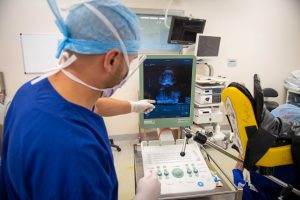Who is suitable for an MRI fusion prostate biopsy?
What are the advantages of the MRI fusion transperineal prostate biopsy?
How is an MRI fusion transperineal prostate biopsy performed?
What to expect after an MRI fusion transperineal prostate biopsy?
Procedure outcomes of MRI Fusion Prostate Biopsy
Post-Operative Care Instructions
MRI fusion transperineal prostate biopsy (MRI fusion TPB) is a technique that is used to accurately and comprehensively sample the prostate for cell changes that may be related to cancer or other conditions affecting the prostate gland. MRI fusion prostate biopsy is the only way to conclusively diagnose prostate cancer.
MRI Fusion Prostate Biopsy Video
Dr Tony de Sousa examining an image from the MRI fusion prostate biopsy

Who is suitable for an MRI fusion prostate biopsy?
MRI fusion Prostate Biopsy is indicated for patients that:
- Have a nodule or other abnormality of the prostate, that has been detected during a digital rectal examination (DRE)
- Have enlargement of the prostate
- Have elevated levels of prostate-specific antigen (PSA) on their blood test
- Have an elevated PSA level, but an ultrasound-guided biopsy has come up negative for prostate cancer
- Have been diagnosed with prostate cancer previously, as part of their ongoing monitoring
What are the advantages of the MRI fusion transperineal prostate biopsy?
- MRI fusion transperineal prostate biopsy allows for the collection of a large number of samples efficiently and accurately
- Enables the entire prostate gland to be sampled to visualize cell changes:
- Allows for the diagnosis of prostate cancer
- In cases where prostate cancer has been diagnosed, allows to check for any changes
- MRI fusion prostate biopsy can be used to diagnose other conditions of the prostate such as:
- Enlargement of the prostate (BPH)
- Inflammation of the prostate, often caused by infection
- Changes in prostate cell type, that is not cancer (PIN)
- No rectal bleeding
- Significantly less risk of infection compared with transrectal (via the rectum) biopsies.
How is an MRI fusion transperineal prostate biopsy performed?
- Before MRI fusion prostate biopsy can take place, the patient will have previously had an MRI scan of the prostate
- MRI fusion trans-perineal prostate biopsy is usually performed under general anaesthetic, and takes around 30-60 minutes to complete
- An ultrasound probe is inserted via the rectum, and using specialised technology, the live ultrasound image is fused with the existing MRI image
- A special biopsy grid with holes 5mm apart is positioned against the skin behind the testicles (the perineum)
- This allows the surgeon to collect biopsies from very specific areas of interest in the prostate.
What to expect after an MRI fusion transperineal prostate biopsy?
- You will be able to go home on the same day following your procedure
- You may have some light bleeding in the perineal area, which is easily managed with gentle pressure
- You may feel some discomfort in the area for a day or two following the procedure
- Some patients notice a small amount of blood in their urine or ejaculate in the days following the procedure, but this usually goes away within a week or so
- Very rarely, the temporary inability to pass urine (urine retention) occurs; this can be fixed by temporary placement of a urinary catheter.
Procedure outcomes of MRI Fusion Prostate Biopsy
The recovery time is very brief and within a couple of days normal activities can be resumed. The samples are examined by a pathologist, and the results are usually available for review by your urologist within a few days. MRI fusion prostate biopsy helps to accurately diagnose and distinguish between cancer and other conditions of the prostate. If required, appropriate treatment can then be initiated.
Post-Operative Care Instructions
What to expect:
- Blood in the urine is common for the first few days following your procedure, but in some cases it may take longer to resolve. This may be intermittent.
- Blood in the semen is common and may persist for a few weeks. It may be bright blood or brownish, old blood. This is because the prostate produces most of the semen fluid. It is not dangerous and may be intermittent.
- Burning and stinging with urination may last for a day or so following the procedure, especially if you’ve had a flexible cystoscopy at the time of the biopsy. This does not usually indicate infection. You may use Ural (available over the counter at pharmacies) to alleviate your symptoms.
- There may be bruising or discomfort in the scrotum or perineum (area between the legs).
Return to activity:
- Driving – no driving for 24 hours
- Work – depending on your occupation, you may be able to return to work the following day, however we recommend taking at least one day off
- Lifting – avoid heavy lifting for at 48 hours
- Activities – you may resume normal activities after 48 hours, including exercise
- Sex – avoid for 48 hours; there is likely to be some blood in the semen for a few weeks but this is not dangerous.
Pain Management:
You may take ibuprofen or paracetamol if you are experiencing pain or discomfort. Ural sachets (available over the counter at pharmacies) can help with burning or stinging with urination.
FAQ:
How long do the biopsy results take?
The results of your biopsy may take a week or more to become available
Head to your nearest hospital emergency room if:
- You unable to urinate (uncommon, but may occur with severe swelling of the prostate or excessive bleeding and clots)
- You have fevers, chills or shakes (may indicate infection).
Follow-Up Information:
Our rooms will arrange a follow-up appointment with your urologist typically 1-2 weeks after your biopsy
Your follow-up appointment is on: ____________________ at __________________.
Contact Information:
If you have any questions or concerns that are not addressed here or in the procedure information available on our website melbourneurologycentre.com.au contact our rooms on 1300 702 811 or [email protected]
Post-Operative information for this procedure can be found here: MRI fusion transperineal prostate biopsy Post-Operative Care Instructions
Written by Dr. Shekib Shahbaz and Dr. Tony de Sousa
Urology Care Foundation, (2019), Exploring Transperineal Prostate Biopsy Facts, [ https://www.urologyhealth.org/healthy-living/care-blog/2019/exploring-transperineal-prostate-biopsy-facts], accessed 28/02/21.
Martorana, E., Pirola, G. M., Aisa, M. C., Scialpi, P., Di Blasi, A., Saredi, G., D’Andrea, A., Signore, S., Grisanti, R., Scialpi, M., (2019), Prostate MRI and transperineal TRUS/MRI fusion biopsy for prostate cancer detection: clinical practice updates, Turkish Journal of Urology, 45(4)[ https://www.ncbi.nlm.nih.gov/pmc/articles/PMC6619838/], accessed 28/02/21.
